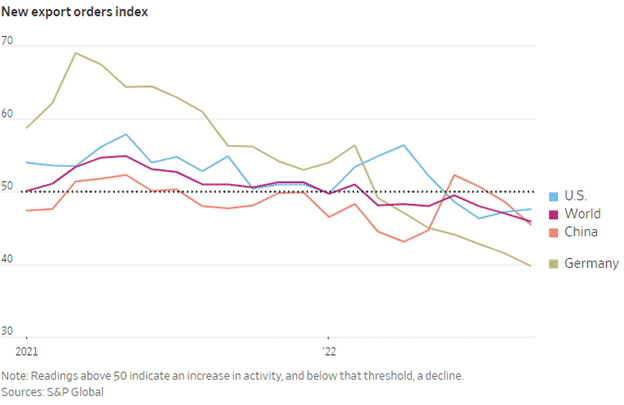The World Trade Organization has released a revised update for imports and exports globally for 2023 that anticipates a steep decline in goods moving between countries, a positive for inflation but a grim portent for recession risk globally according to the Wall Street Journal.
The WTO has lowered its forecasts for global trade to just 1% growth for next year, a sharp decline from the previous estimate of 3.4%, driven by inflation’s erosion of household buying power as well as soaring energy costs for parts of the world. While reduced demand will be a reprieve for supply chains that have been in catch-up mode ever since the onset of COVID-19 in 2020, it puts global recession risk odds that much higher.

Image source: Wall Street Journal
“The global economy faces a multipronged crisis,” Ngozi Okonjo-Iweala, secretary-general of the WTO, told the WSJ. “The picture for 2023 has darkened considerably.”
Global growth estimates for 2023 have also been reduced by the WTO, dropping from 3.3% to 2.3%, a number that could decline even further depending on how aggressively central banks raise interest rates.
“One has to watch out if there are supply-side constraints that are not responsive to interest rates,” Okonjo-Iweala said. “There is a danger you could overshoot.”
New export orders dropped at the fastest rate since June 2020 for September, driven in part by Europe’s ongoing energy crisis, persistent inflation in developed countries, and China’s drop-off in imports as it contends with COVID lockdowns and its faltering real estate sector. All have led to a pullback in demand for exports that looks to continue well into next year.
Riding the Rising Recession Tide With Managed Futures
Investing in the current environment of pronounced, prolonged market volatility has been an ongoing challenge, particularly as markets remain driven by investor sentiment and fear. CNN’s Fear and Greed Index is a compilation of several market measurements designed to put a finger on the pulse of investor and market behavior. It measures momentum, price strength of stocks, junk bond demand, put and call options, stock price breadth, volatility, and safe haven demand.
Fear typically drives prices below their value whereas greed can inflate prices. Currently, the measurement is 29, solidly on the fear side and inching downwards towards extreme fear.
Investors looking for a fund that removes sentiment from investing and instead focuses on current trends should consider the iMGP DBi Managed Futures Strategy ETF (DBMF), a managed futures fund designed to capture performance no matter how equity markets are moving.
The fund seeks long-term capital appreciation by investing in some of the most liquid U.S.-based futures contracts in a strategy utilized by hedge funds and has 29.19% returns year-to-date as of 10/04/2022. It has an AUM of over $920 million, the largest of any managed futures ETF.
DBMF allows for the diversification of portfolios across asset classes that are uncorrelated to traditional equities or bonds. It is an actively managed fund that uses long and short positions within derivatives, mostly futures contracts, and forward contracts. These contracts span domestic equities, fixed income, currencies, and commodities (via its Cayman Islands subsidiary).
The position that the fund takes within domestic managed futures and forward contracts is determined by the Dynamic Beta Engine. This proprietary, quantitative model attempts to ascertain how the largest commodity-trading advisor hedge funds have their allocations. It does so by analyzing the trailing 60-day performance of CTA hedge funds and then determining a portfolio of liquid contracts that would mimic the hedge funds’ performance (not the positions).
DBMF takes long positions in derivatives with exposures to asset classes, sectors, or markets that are anticipated to grow in value and takes short positions in derivatives with exposures expected to fall in value. Under normal market conditions, the fund seeks to maintain volatility between 8%–10% annually.
DBMF has a management fee of 0.95%.
For more news, information, and strategy, visit the Managed Futures Channel.

